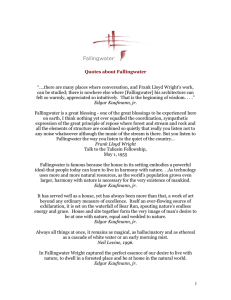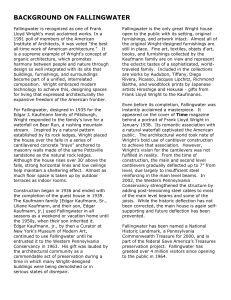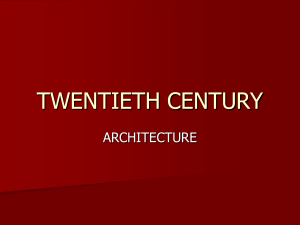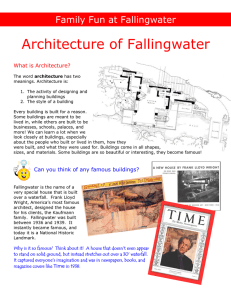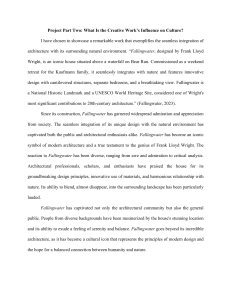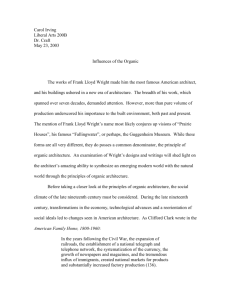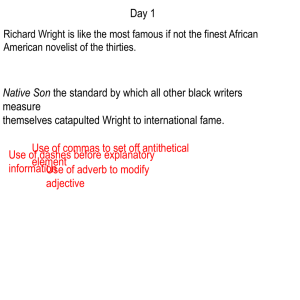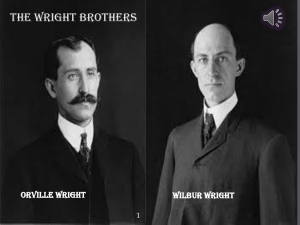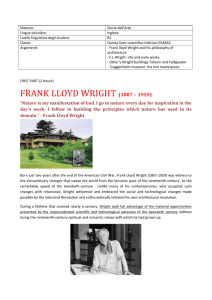Frank Lloyd Wright Fallingwater
advertisement
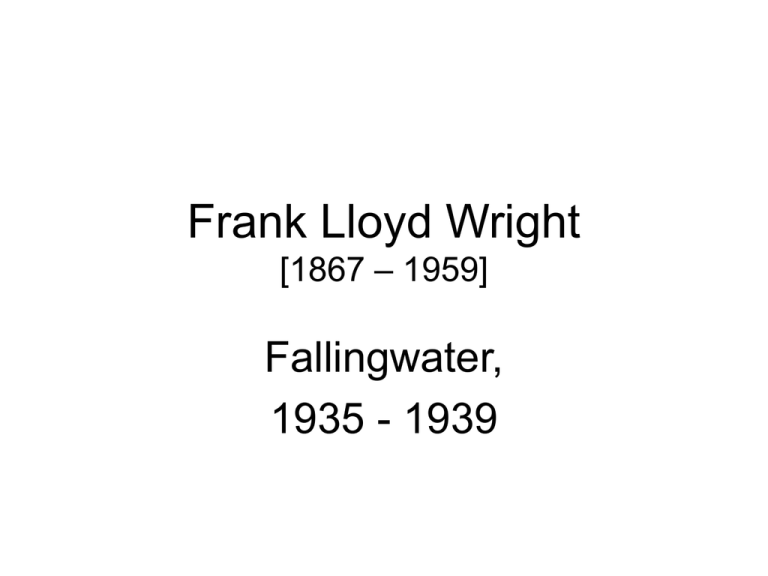
Frank Lloyd Wright [1867 – 1959] Fallingwater, 1935 - 1939 Perspective drawing of Edgar J. Kaufmann House, 1936. Copyright © the Frank Lloyd Wright Foundation • Frank Lloyd Wright was an American architect, interior designer, writer and educator, who designed more than 1,000 projects, which resulted in more than 500 completed works. • Wright promoted organic architecture was a leader of the Prairie School movement of architecture. • Fallingwater is a man-made dwelling suspended above a waterfall. • It offers an imaginative solution to a perennial American problem: how to enjoy a civilized life without intruding upon the natural world. • Especially in the United States, which had once possessed infinite acres of unspoiled land, technological progress almost always comes at the expense of nature. • A long tradition of American landscape painting had developed partly to satisfy city dwellers with restorative glimpses of the countryside they’d left behind. • Thomas Cole’s The Oxbow • With Fallingwater, Frank Lloyd Wright went one step further—designing a house nestled into a mountainside, with views that made the house appear to be part of nature itself. • Fallingwater has been described as the "the best-known private home for someone not of royal blood in the history of the world." • Fallingwater was commissioned by Edgar J. Kaufmann, founder of a prominent Pittsburgh department store. • To escape the pressures of business, Kaufmann and his family regularly left the city for their sixty-acre woodland retreat in the Allegheny Mountains. • By 1935, the Kaufmanns’ country cabin was falling apart, and Wright was invited to design them a new weekend residence. • Kaufmann undoubtedly envisioned a house overlooking the most outstanding feature of the property, a mountain stream cascading over dramatically projecting slabs of stone. • Wright believed that a country home should become part of the landscape • Perched over a waterfall on Bear Run in the western Pennsylvania highlands, the rural retreat has also been called the fullest realization of Wright's lifelong ideal of a living place completely at one with nature. • He studied the site from every point of view before making the audacious proposal to build the house on the side of the cliff. • The waterfall itself would be invisible from the interior but wholly integrated into the plan, with a stairway from the living room giving direct access and the rush of falling water always echoing through the house. • Wright had never been constrained by convention, but even for him, the design for Fallingwater is a stunning feat of invention and one of the most original and groundbreaking concepts in the history of architecture. • A traditional country house would have been set back from the road on a manicured lawn with a pleasing view of the wilder regions that lay safely beyond its boundaries. • Wright reversed that idea. • Fallingwater, a large, low structure hovering like a boulder over the falls, seems almost as much a part of nature as apart from it. • Fallingwater is like a piece of contemporary abstract art from the twentieth century that we have looked at during this class. • It’s been simplified into basic, essential shapes without added ornamentation. • What shapes do you see? • Every element of the architecture is meant to blur the distinction between the natural and built environments, and to integrate the residents into the out-of-doors. • Reinforced-concrete cantilever slabs project from the rocks to carry the house over the stream. • Deeply recessed rooms, fieldstone interiors, and unusually low ceilings create the impression of a cave—a private, sheltered space within the natural scheme of things. • From the living room, a suspended stairway leads directly down to the stream. • On the third level immediately above, terraces open from sleeping quarters, emphasizing the horizontal nature of the structural forms. • Fallingwater is constructed on three levels primarily of reinforced concrete, native sandstone and glass. • Soaring cantilevered balconies are anchored in solid rock. • Walls of glass form the south exposure, and a vertical shaft of mitered glass merges with stone and steel to overlook the stream. • If, through light and sound and structure, Fallingwater evokes the feeling of existing in the unspoiled American wilderness, everything else about it is unmistakably modern. • The house is a marvel of twentieth-century technology. • Although it proved impractical for all sorts of reasons, it was the architect’s (if not the client’s) dream house, and Wright would not permit a single alteration to his plan. • The most striking element of the design— and the biggest engineering challenge—is the series of reinforced concrete terraces cantilevered above the rocky ledges and parallel to the natural lines of the site. • Although firmly anchored in solid rock, the terrace platforms appear to defy gravity; Wright compared them to trays balanced on a waiter’s fingers. • Between the terraces are rooms with glass walls—transparent boundaries between inside and out. • Walls not made of glass are built of locally quarried stone, and the massive, central fireplace is composed of boulders removed from the site to make way for construction but restored to form the hearth, the traditional heart of a home. • As the distinguished scholar and architecture critic Ada Louise Huxtable has observed, the effect of Fallingwater “is not of nature violated, but of nature completed—a dual enrichment.” Styles associated with Frank Lloyd Wright • • • • Prairie Style Mission Style Craftsman Style Arts and Crafts Style Stained Glass Oak Park, IL Winslow House, Forrest Park, IL Florida Southern College, Lakeland, FL Kentuck Knob House Essay Question 1 • Why might a city dweller enjoy this house? • Imagine being on one of the balconies. What would you hear? Essay Question 2 • The Kaufmanns wanted a vacation home on their land. • Why was the location that Wright chose for the house a surprise to them? • Where would most architects probably have located the house to take advantage of the natural waterfall? Essay Question 3 • How is Fallingwater like a piece of contemporary abstract art from the twentieth century?
